PbWO4 Acoustic Properties Measurement by Laser Ultrasonics with the Aim of Optical Damage Recovery
Abstract
:1. Introduction
2. Materials and Methods
2.1. Bulk and Lattice Waves Propagation in PWO
- Acoustic waves, whose frequencies ωk(ξ) are going to zero for ξ → 0;
- Optic waves, for which the limit for ξ → 0 is different from zero: the limit ωk(0) is called the cut-off frequency with group velocities vkg(0) = 0;
- Standing waves, associated with imaginary values ξ = ±ik, k > 0 for some frequencies, do not propagate but keep oscillating, increasing or decreasing, in a given, limited region within the crystal.
- There ever existed three acoustic and nine optical waves;
- The cut-off frequencies for the optical waves are the limit as ξ → 0 of the eigenvalues of (3);
- The frequencies for the acoustic waves are the eigenvalues of (3), which are going to zero in the limit for ξ → 0;
- The eigenvectors for ξ → 0 are real;
- There are no standing waves.
- Non uniform dilatation:
- Dilatation along e3 and uniform plane strain in the orthogonal plane:
- Shear in the plane orthogonal to e3:
- Shear between e3 and the direction e⊥ = α e1 + β e2:
- Rigid rotation around the direction e3:
- Rigid rotation around the direction e⊥ = ω1 e1 + ω2 e2:
2.2. Crystal Samples (PWO)
2.3. Laser Ultrasonic Excitation and Measurement Set-Up
2.4. Data Acquisition and Processing
- Apply the laser ultrasonic method to measure the acoustic properties (speed of sound, acoustic impedance, acoustic reflection coefficient, and acoustic transmission coefficient) of PWO crystals by a fully non-contact method.
- Assess if the pulsed laser excitation of PWO crystals causes any recovery of the crystal’s optical properties (an increase in optical transmittance).
2.5. Light Transmittance Measurements
3. Results
3.1. Measurement of Acoustic Properties of PWO
3.2. Effect of Laser Pulses on Optical Transmittance
4. Discussion
5. Conclusions
Author Contributions
Funding
Acknowledgments
Conflicts of Interest
References
- Annenkov, A.A.; Korzhik, M.V.; Lecoq, P. Lead tungstate scintillation material. Nucl. Instrum. Methods Phys. Res. Sect. A Accel. Spectrometers Detect. Assoc. Equip. 2002, 490, 30–50. [Google Scholar] [CrossRef]
- Annenkov, A.; Borisevitch, A.; Hofstaetter, A.; Korzhik, M.; Ligun, V.; Lecoq, P.; Missevitch, O.; Novotny, R.; Peigneux, J.P. Improved light yield of lead tungstate scintillators. Nucl. Instrum. Methods Phys. Res. Sect. A Accel. Spectrometers Detect. Assoc. Equip. 2000, 450, 71–74. [Google Scholar] [CrossRef]
- Ye, C.; Liao, J.; Shao, P.; Xie, J. Growth and scintillation properties of F-doped PWO crystals. Nucl. Instrum. Methods Phys. Res. Sect. A Accel. Spectrometers Detect. Assoc. Equip. 2006, 566, 757–761. [Google Scholar] [CrossRef]
- Lecoq, P.; Annenkov, A.; Gektin, A.; Korzhik, M.; Pedrini, C. Inorganic Scintillators for Detector Systems, Physical Principles and Crystal Engineering, Physical Principles and Crystal Engineering, Series: Particle Acceleration and Detection, XII; Springer: Berlin/Heidelberg, Germany, 2006; ISBN 978-3-540-27768-2. [Google Scholar]
- Moreau, J.M.; Galez, P.; Peigneux, J.P.; Korzhik, M.V. Structural characterization of PbWO4 and related new phase Pb7W8O(32−x). J. Alloy. Compd. 1996, 238, 46–48. [Google Scholar] [CrossRef]
- Ishii, M.; Harada, K.; Kobayashi, M.; Usuki, Y.; Yazawa, T. Mechanical properties of PbWO4 scintillating crystals. Nucl. Instrum. Methods Phys. Res. Sect. A Accel. Spectrometers Detect. Assoc. Equip. 1996, 376, 203–207. [Google Scholar] [CrossRef] [Green Version]
- Baccaro, S.; Barone, L.M.; Borgia, B.; Castelli, F.; Cavallari, F.; Dafinei, I.; De Notaristefani, F.; Diemoz, M.; Festinesi, A.; Leonardi, E.; et al. Ordinary and extraordinary complex refractive index of the lead tungstate (PbWO4) crystal. Nucl. Instrum. Methods Phys. Res. Sect. A Accel. Spectrometers Detect. Assoc. Equip. 1997, 385, 209–214. [Google Scholar] [CrossRef]
- Natali, P.P.; Montalto, L.; Daví, F.; Mengucci, P.; Ciriaco, A.; Paone, N.; Rinaldi, D. Theoretical and experimental evaluation of piezo-optic parameters and photoelastic constant in tetragonal PWO. Appl. Opt. 2018, 57, 730–737. [Google Scholar] [CrossRef]
- Rinaldi, D.; Daví, F.; Montalto, L. On the photoelastic constants and the Brewster law for stressed tetragonal crystals. Math. Methods Appl. Sci. 2018, 41, 3103–3116. [Google Scholar] [CrossRef]
- Natali, P.P.; Montalto, L.; Scalise, L.; Davì, F.; Paone, N.; Rinaldi, D. Fringe modelling and Photoelastic stress Measurement method in tetragonal {PWO} observed in the plane normal to a crystallographic a-axis. J. Instrum. 2020, 15, P09037. [Google Scholar] [CrossRef]
- Rinaldi, D.; Ciriaco, A.; Lebeau, M.; Paone, N. Quality control on pre-serial Bridgman production of PbWO4 scintillating crystals by means of photoelasticity. Nucl. Instrum. Methods Phys. Res. Sect. A Accel. Spectrometers Detect. Assoc. Equip. 2010, 615, 254–258. [Google Scholar] [CrossRef]
- Montalto, L.; Natali, P.P.; Daví, F.; Mengucci, P.; Paone, N.; Rinaldi, D. Characterization of a defective PbWO4 crystal cut along the a-c crystallographic plane: Structural assessment and a novel photoelastic stress analysis. J. Instrum. 2017, 12, P12035. [Google Scholar] [CrossRef] [Green Version]
- Rinaldi, D.; Montalto, L.; Lebeau, M.; Mengucci, P. Influence of a Surface Finishing Method on Light Collection Behaviour of PWO Scintillator Crystals. Photonics 2018, 5, 47. [Google Scholar] [CrossRef] [Green Version]
- Mengucci, P.; Di Cristoforo, A.; Lebeau, M.; Majni, G.; Paone, N.; Pietroni, P.; Rinaldi, D. Surface quality inspection of PbWO(4) crystals by grazing incidence x-ray diffraction. Nucl. Instrum. Methods Phys. Res. Sect. A Accel. Spectrometers Detect. Assoc. Equip. 2005, 537, 207–210. [Google Scholar] [CrossRef]
- Lebeau, M.; Gobbi, L.; Majni, G.; Paone, N.; Pietroni, P.; Rinaldi, D. Mapping residual stresses in PbWO4 crystals using photo-elastic analysis. Nucl. Instrum. Methods Phys. Res. Sect. A Accel. Spectrometers Detect. Assoc. Equip. 2005, 537, 154–158. [Google Scholar] [CrossRef]
- Ciriaco, A.; Daví, F.; Lebeau, M.; Majni, G.; Paone, N.; Pietroni, P.; Rinaldi, D. PWO photo-elastic parameter calibration by laser-based polariscope. Nucl. Instrum. Methods Phys. Res. Sect. A Accel. Spectrometers Detect. Assoc. Equip. 2007, 570, 55–60. [Google Scholar] [CrossRef]
- The CMS Collaboration. The Electromagnetic Calorimeter Technical Design Report CERN/LHCC 97-033; CERN: Geneva, Switzerland, 1997; Volume 4. [Google Scholar]
- Auffray, E.; Lecoq, P.; Paoletti, S.; Sempere, P.; Vigo, E.; Schneegans, M. Status of PbWO-4 crystals R\&D and preproduction from BTCP for the CMS calorimeter. Nucl. Phys. B Proc. Suppl. 1999, 78, 197–202. [Google Scholar] [CrossRef]
- The CMS Collaboration. CMS, the Compact Muon Solenoid: Technical Proposal; Report Number “CERN-LHCC-94-38, CERN-LHCC-P-1”; CERN: Geneva, Switzerland, 1994. [Google Scholar]
- Arduini, G.; Barranco, J.; Bertarelli, A.; Biancacci, N.; Bruce, R.; Brüning, O.; Buffat, X.; Cai, Y.; Carver, L.R.; Fartoukh, S.; et al. High Luminosity LHC: Challenges and plans. J. Instrum. 2016, 11, C12081. [Google Scholar] [CrossRef]
- Apollinari, G.; Bejar Alonso, I.; Bruning, O.; Lamont, M.; Rossi, L. High-Luminosity Large Hadron Collider (HL-LHC): Preliminary Design Report; CERN Yellow Reports: Monographs; CERN: Geneva, Switzerland, 2015. [Google Scholar]
- Erni, W.; Keshelashvili, I.; Krusche, B.; Steinacher, M.; Heng, Y.; Liu, Z.; Liu, H.; Shen, X.; Wang, Q.; Xu, H.; et al. Technical design report for the PANDA (AntiProton Annihilations at Darmstadt) Straw Tube Tracker. Eur. Phys. J. A 2013, 49, 25. [Google Scholar] [CrossRef] [Green Version]
- Novotny, R.W.; Bremer, D.; Dormenev, V.; Drexler, P.; Eissner, T.; Kuske, T.; Moritz, M. High-quality PWO crystals for the PANDA-EMC. J. Phys. Conf. Ser. 2011, 293, 012003. [Google Scholar] [CrossRef]
- Ikegami Andersson, W. The PANDA Detector at FAIR. J. Phys. Conf. Ser. 2016, 770, 012043. [Google Scholar] [CrossRef] [Green Version]
- Boca, G. The PANDA experiment: Physics goals and experimental setup. EPJ Web Conf. 2014, 72, 2. [Google Scholar] [CrossRef] [Green Version]
- Barysevich, A.; Dormenev, V.; Fedorov, A.; Glaser, M.; Kobayashi, M.; Korjik, M.; Maas, F.; Mechinski, V.; Rusack, R.; Singovski, A.; et al. Radiation damage of heavy crystalline detector materials by 24GeV protons. Nucl. Instrum. Methods Phys. Res. A 2013, 701, 231–234. [Google Scholar] [CrossRef]
- Borisevitch, A.E.; Dormenev, V.I.; Fedorov, A.A.; Korjik, M.V.; Kuske, T.; Mechinsky, V.; Missevitch, O.V.; Novotny, R.W.; Rusack, R.; Singovski, A.V. Stimulation of radiation damage recovery of lead tungstate scintillation crystals operating in a high dose-rate radiation environment. IEEE Trans. Nucl. Sci. 2013, 60, 1368–1372. [Google Scholar] [CrossRef]
- Auffray, E.; Korjik, M.; Singovski, A. Experimental study of lead tungstate scintillator proton-induced damage and recovery. IEEE Trans. Nucl. Sci. 2012, 59, 2219–2223. [Google Scholar] [CrossRef] [Green Version]
- Adzic, P.; Almeida, N.; Andelin, D.; Anicin, I.; Antunovic, Z.; Arcidiacono, R.; Arenton, W.; Auffray, E.; Argiro, S.; Askew, A.; et al. Radiation hardness qualification of PbWO4 scintillation crystals for the CMS Electromagnetic Calorimeter. J. Instrum. 2010, 5, P03010. [Google Scholar] [CrossRef] [Green Version]
- Millers, D.; Grigorjeva, L.; Chernov, S.; Popov, A.; Lecoq, P.; Auffray, E. The temperature dependence of scintillation parameters in PbWO4 crystals. Phys. Stat. Sol. 1997, 203, 585–589. [Google Scholar] [CrossRef]
- Daví, F. Wave propagation in micromorphic anisotropic continua with an application to tetragonal crystals. Math. Mech. Solids 2020, 26, 804–822. [Google Scholar] [CrossRef]
- Born, M.; Huang, K. Dynamical Theory of Crystal Lattices; Clarendon Press: Oxford, UK, 1998; ISBN 9780198503699. [Google Scholar]
- Capriz, G. Continua with Microstructure; Springer: New York, NY, USA, 1989; ISBN 978-1-4612-3584-2. [Google Scholar]
- Scalise, L.; Rinaldi, D.; Davì, F.; Paone, N. Measurement of ultimate tensile strength and Young modulus in LYSO scintillating crystals. Nucl. Instrum. Methods Phys. Res. Sect. A Accel. Spectrometers Detect. Assoc. Equip. 2011, 654, 122–126. [Google Scholar] [CrossRef]
- Rothberg, S.J.; Allen, M.S.; Castellini, P.; Di Maio, D.; Dirckx, J.J.J.; Ewins, D.J.; Halkon, B.J.; Muyshondt, P.; Paone, N.; Ryan, T.; et al. An international review of laser Doppler vibrometry: Making light work of vibration measurement. Opt. Lasers Eng. 2017, 99, 11–22. [Google Scholar] [CrossRef] [Green Version]
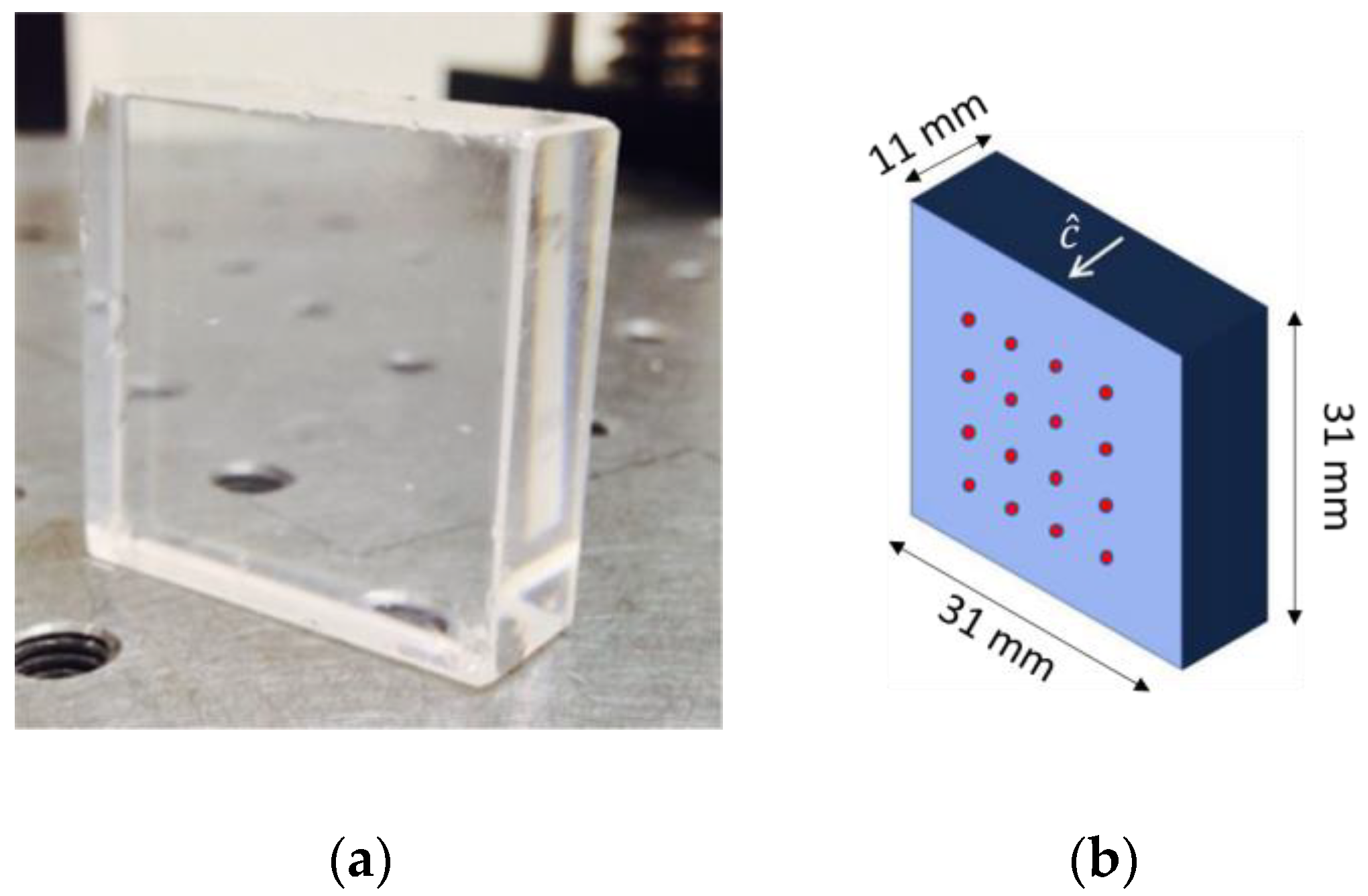
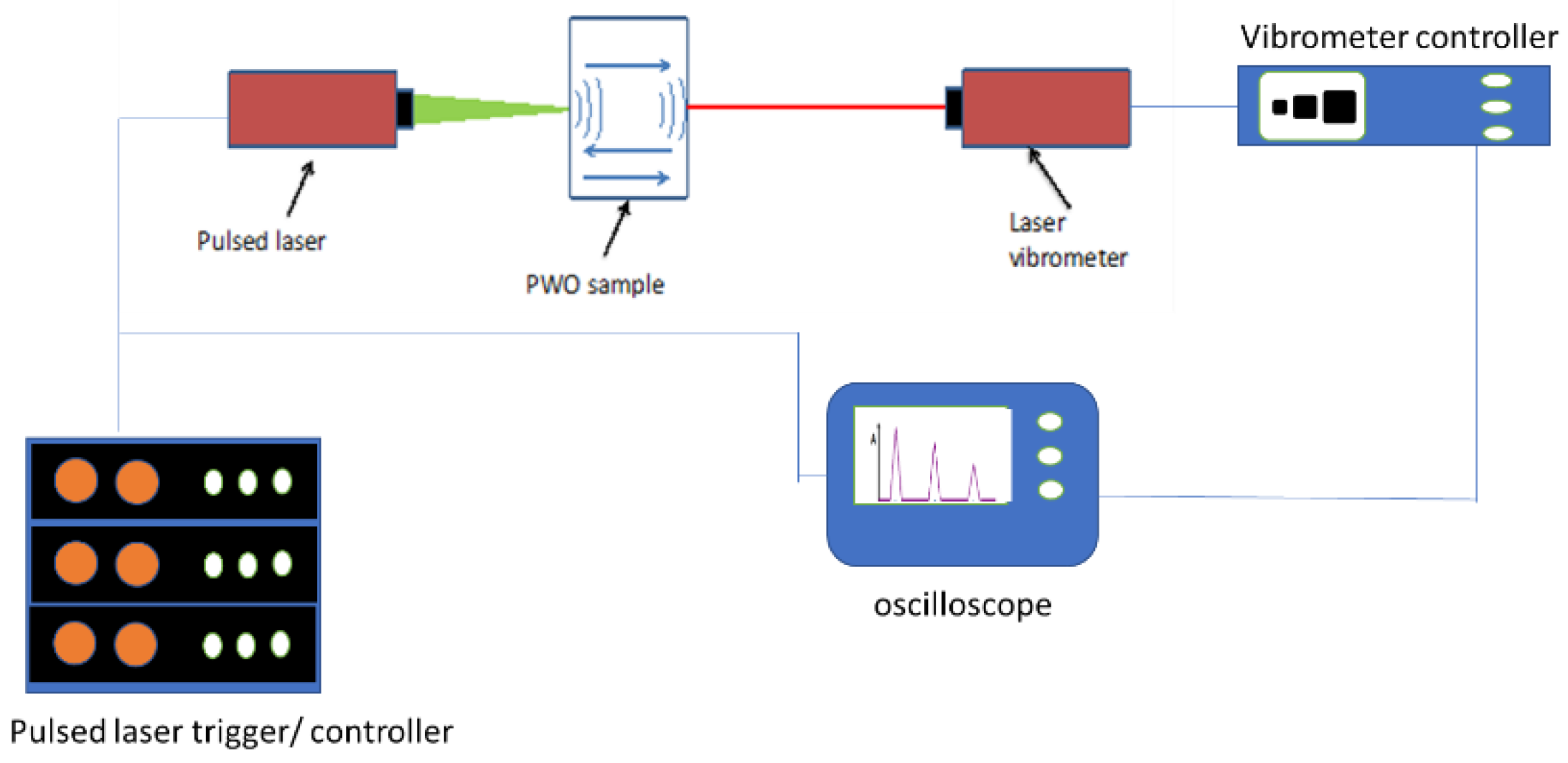

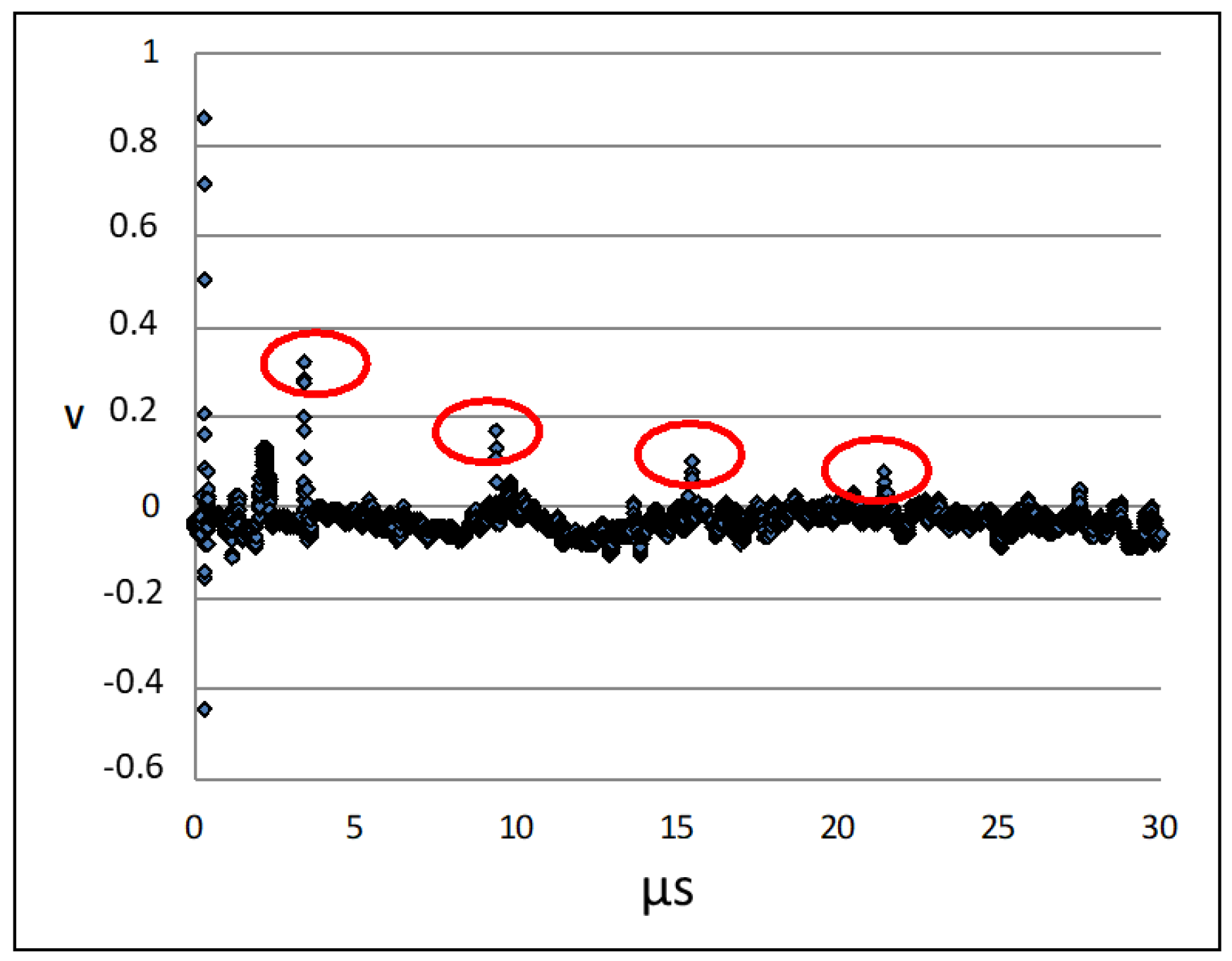




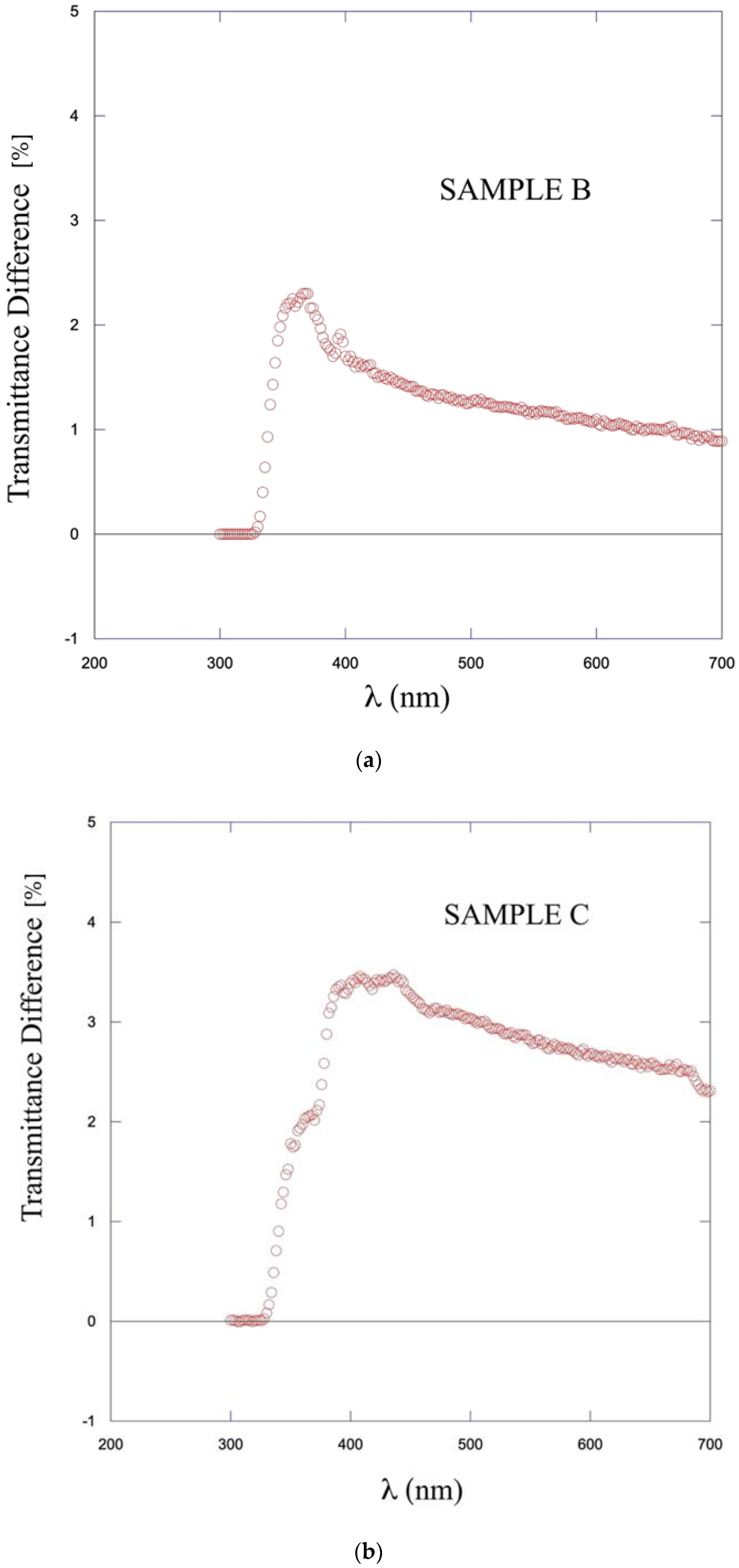
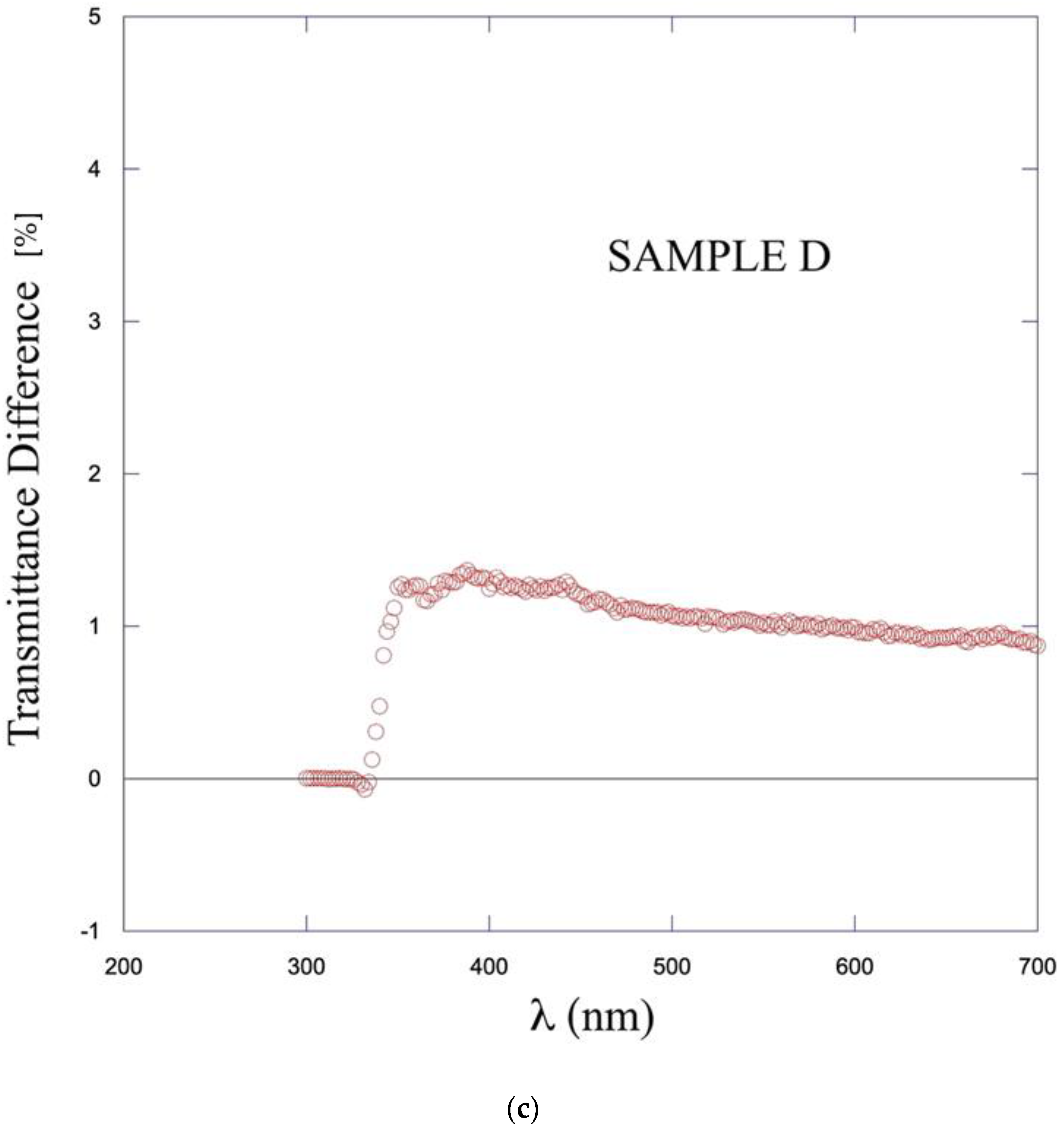
Disclaimer/Publisher’s Note: The statements, opinions and data contained in all publications are solely those of the individual author(s) and contributor(s) and not of MDPI and/or the editor(s). MDPI and/or the editor(s) disclaim responsibility for any injury to people or property resulting from any ideas, methods, instructions or products referred to in the content. |
© 2023 by the authors. Licensee MDPI, Basel, Switzerland. This article is an open access article distributed under the terms and conditions of the Creative Commons Attribution (CC BY) license (https://creativecommons.org/licenses/by/4.0/).
Share and Cite
Montalto, L.; Davì, F.; Dormenev, V.; Paone, N.; Rinaldi, D. PbWO4 Acoustic Properties Measurement by Laser Ultrasonics with the Aim of Optical Damage Recovery. Crystals 2023, 13, 556. https://doi.org/10.3390/cryst13040556
Montalto L, Davì F, Dormenev V, Paone N, Rinaldi D. PbWO4 Acoustic Properties Measurement by Laser Ultrasonics with the Aim of Optical Damage Recovery. Crystals. 2023; 13(4):556. https://doi.org/10.3390/cryst13040556
Chicago/Turabian StyleMontalto, Luigi, Fabrizio Davì, Valery Dormenev, Nicola Paone, and Daniele Rinaldi. 2023. "PbWO4 Acoustic Properties Measurement by Laser Ultrasonics with the Aim of Optical Damage Recovery" Crystals 13, no. 4: 556. https://doi.org/10.3390/cryst13040556





